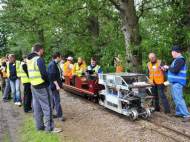UK’s first hydrogen powered locomotive prototype
 While there are efforts to initiate production of hydrogen powered vehicles such as cars and airplanes, I believe the easiest transition toward this technology in transportation should be achieved by railway. So do the engineering students and staff at the University of Birmingham, who have designed and built a prototype hydrogen powered locomotive – the first of its kind to operate in the UK.
While there are efforts to initiate production of hydrogen powered vehicles such as cars and airplanes, I believe the easiest transition toward this technology in transportation should be achieved by railway. So do the engineering students and staff at the University of Birmingham, who have designed and built a prototype hydrogen powered locomotive – the first of its kind to operate in the UK.
Hydrogen provides a clean source of energy and it offers a considerable extension in range in comparison to battery only operation. Most common problems for cars and airplanes is the fact that hydrogen requires large tanks to be stored, and that shouldn’t be a problem for a locomotive which is already pulling many carts.
This narrow gauge locomotive designed by the researchers from the University of Birmingham weights 320kg, and it’s a hybrid which combines a 1.1 kW PEM hydrogen fuel cell and lead acid batteries. The fuel cell is used both to power the permanent magnet electric motors and to charge the batteries, while the batteries help to meet the peak power demands when accelerating under load.
Hydrogen storage for this project relies on a previous project of Professor Rex Harris, University of Birmingham’s School of Metallurgy and Materials, who devised it for the hydrogen hybrid canal boat named Ross Barlow. It allows storage of more than 5,000 liters of hydrogen in a solid state metal hydride tank at relatively low pressure of 5 bars at which the system typically operates.
“Our hydrogen powered locomotive is a clean and efficient example of how hydrogen power could work for future trains on non-electrified routes. We hope that our efforts will encourage the rail industry to take a closer look at this exciting technology”, said Dr Stuart Hillmansen, from the University of Birmingham’s School of Electronic, Electrical and Computer Engineering, who advised the team.
This amount of hydrogen would enable the locomotive to haul a 4,000 kg load up over 2,700 m, and two additional tanks can be easily fitted to further extend its range. The locomotive also features regenerative braking to capture, store and re-use braking energy, as well as adjustable air suspension and a highly advanced touchscreen remote control that operates over a Wi-Fi link.
The locomotive was tested at the Stapleford Miniature Railway in Leicestershire as part of the IMechE Railway Challenge – a competition led by the Institute of Mechanical Engineering. There are still many other developments needed before this technology replaces currently used locomotives, but we’re a step closer toward that goal.









Nice effort and demo, but I don’t think it’s worth the prize since it is still way too far from practical application.
Isn’t it better to push the research of those modern super-trains instead?